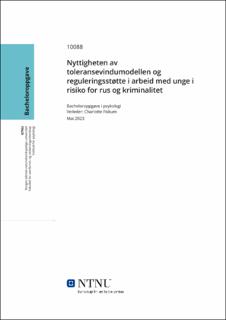| dc.contributor.advisor | Charlotte Fiskum | |
| dc.contributor.author | Birgit Stork | |
| dc.date.accessioned | 2023-07-04T17:19:28Z | |
| dc.date.available | 2023-07-04T17:19:28Z | |
| dc.date.issued | 2023 | |
| dc.identifier | no.ntnu:inspera:146342237:47611203 | |
| dc.identifier.uri | https://hdl.handle.net/11250/3075762 | |
| dc.description.abstract | Dette er en kvalitativ studie som undersøker nytten av toleransevindumodellen og reguleringsstøtte i arbeid med unge i risiko hos oppsøkende tjenester i Norge. Emosjonsregulering har vist seg å være sentralt for ens helse og risiko for rusproblemer, og toleransevindumodellen kan forklare dette ytterligere. Forebygging av rusproblematikk er viktig og aktuelt i dagens samfunn. En tematisk analyse av en spørreundersøkelse og ni intervjuer fant at toleransevindumodellen er nyttig som en forståelsesramme, og at ungdomsarbeidet i oppsøkende tjenester er med på å regulere ungdommen. En av de måtene ungdommene reguleres på, viste seg å være gjennom aktiviteter. Studien bidrar med kunnskap og bevisstgjøring av informantenes erfaringer og meninger, og skaper oppmerksomhet rundt toleransevindumodellen som verktøy. Videre vil det være nyttig å undersøke bruk av toleransevindumodellen og reguleringsstøttende arbeid nærmere og hvilket utviklingspotensial det har. | |
| dc.description.abstract | This is a qualitative study that examines the usefulness of the window of tolerance-model and regulatory support in work with young people at risk in outreach services in Norway. Emotion regulation has been shown to be central to one’s health and to the risk of substance abuse problems, and the window of tolerance-model can explain this further. Prevention of drug problems is important and relevant today. A thematic analysis of a survey and nine interviews found that the window of tolerance-model is useful as a framework for understanding, and that youth work in outreach services helps to regulate young people. One of the ways in which the youths are regulated turned out to be through activities. This study contributes with knowledge and awareness around the informants’ experiences and opinions and creates attention around the use of the window of tolerance-model as a tool. Furthermore, it will be useful to examine the use of the window of tolerance-model and regulatory support in more detail and what potential this could have. | |
| dc.language | nob | |
| dc.publisher | NTNU | |
| dc.title | Nyttigheten av toleransevindumodellen og reguleringsstøtte i arbeid med unge i risiko for rus og problematikk | |
| dc.type | Bachelor thesis | |
